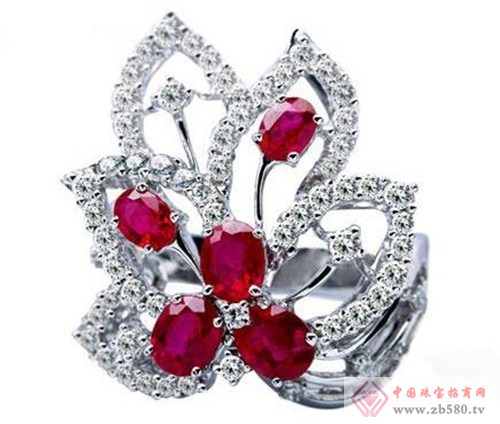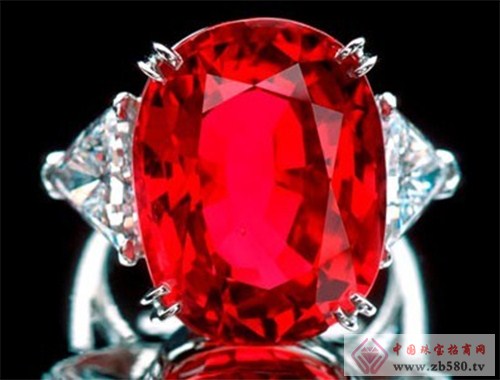Ruby
Red is the color that the Chinese think is festive, which represents love, strength and enthusiasm, and also symbolizes the red fire of life. In the fascinating world of colored gems, rubies are recognized as the king of gems. Natural rubies are mostly from Asia (Myanmar, Thailand and Sri Lanka), Africa and Australia, and there is also a bit in Montana and South Carolina. Natural rubies are rare and precious, and industrial rubies are artificial. Definition of ruby Ruby refers to the red and pink corundum. It is a kind of corundum. The main component is alumina (Al2O3). The red color is from chromium (Cr), mainly Cr2O3. The content is generally 0.1-3%, the highest. Up to 4%. Ruby is among the top five precious stones in the world and is a precious jewel variety. The world of gemology defines the ruby ​​as the birthstone of July. Ruby culture Ruby red hot makes people always associate it with enthusiasm and love. It is known as the "stone of love", symbolizing the enthusiasm of fire, the beauty, eternal and firmness of love. Ruby is the most precious of all gems in the Bible. Ruby is the birthstone of July and a memorial stone for the 15th, 40th and 80th anniversary of marriage. Rubies of different colors come from different countries, but they also mean auspiciousness. Red is always the messenger of beauty, and ruby ​​is the best guide to give wishes to others. Also because of the brilliance of rubies, people agree that rubies are more suitable for wearing on mature women. In general, Ruby can be much more expensive than diamonds, but rubies are rarer than diamonds. Therefore, if you are fortunate enough to meet your favorite ruby, within the scope of the economy, you will have no hesitation. Ruby value identification Ruby grading standards are mainly based on 1T and 4C: Transparency, Colour, Clarity, Cut, Carat. In the naked eye identification of ruby, the transparency is generally divided into five levels: transparent, translucent, translucent, translucent, and opaque. The more transparent the ruby, the better; the color: the color of ruby ​​is various, red, orange, Pink, magenta, dark red, of which pure red is the best. Clarity: The clarity of ruby ​​refers to some mineral inclusions and gas-liquid inclusions formed inside the ruby ​​during the formation process. Therefore, a good ruby ​​has as few inclusions as possible. Cut: Ruby cuts are mainly considered from the aspects of ç¢ type, proportion, symmetry and degree of modification. ç¢ type refers to the shape of jewel cut, usually oval, round multi-face, emerald and so on. The ratio refers to the ratio of the waist width of the dome to the full depth, and the generally acceptable ratio is 60% to 80%. Symmetry refers to whether the waist circle is symmetrical, whether the bottom point is eccentric, and whether the table top is tilted. The degree of modification refers to the uniformity of the facet arrangement, the quality of the polishing, and the like. Type of ruby The brighter the red color of Ruby, the more beautiful and valuable it is. The color of the best in ruby ​​is called "pigeon blood red". Its red color is more pure, saturated and bright, but it also gives a strong feeling of "burning fire" and "flowing blood". The beauty of (Ruby) is unobstructed. Many people have seen the "pigeon blood red" and they have never forgotten about it. The red light of this gem seems to be more than just a red color, as if something is burning in the gem. "Big Blood" Ruby is mainly produced in a legendary mine in northern Myanmar - Mo Valley. It is said to be blood, because experts have compared the red color of Ruby with the various reds in nature, only to find that only the blood in the adult pigeon arteries in Myanmar is relatively close, and This blood must be fresh, beating blood. Once the blood leaves the pigeon's body for more than a dozen seconds, the color can no longer be compared to the "pigeon" Ruby. "Pigeon blood" is the best in ruby, but ordinary (Ruby) is also very rare and precious. Ruby embodies the three main characteristics of high-quality gemstones: glamorous beauty, high rarity and excellent durability. The beauty of Ruby is first reflected in its unique red color. Although there are many kinds of red gems in nature, only ruby ​​red can bring the most shocking visual impact. High quality rubies are extremely rare and extremely difficult to obtain. In Myanmar, an average of about 1 carat of Ruby ore can be screened out for every 400 tons of ruby ​​ore. After re-selecting these ruby ​​ore, only 1000 of this ore can be selected. One – a ruby-grade ruby ​​in terms of color, clarity, weight, and more. Ruby's durability is mainly due to its excellent hardness and high temperature resistance. Ruby has a Mohs hardness of 9, second only to diamonds, and is the second hardest substance in nature. At the same time it can withstand temperatures of about 2000 degrees Celsius without melting, which is much higher than the burning point of diamonds less than 1000 degrees Celsius. Therefore, whether it is worn as a jewellery or as a private collection, it can be changed without fear of the environment. Origin of ruby: 1. Burma Ruby: Myanmar is the most famous place for rubies. Since ancient times, Burmese rubies have become famous. In particular, a ruby ​​called "pigeon red" produced in the Mogu area in northern Burma is more crowned as a ruby. It is bright. Eye-catching, like the blood of the local pigeon bird, it is named "pigeon blood red", the color distribution of Burmese ruby ​​is uneven, often in the form of thick and faint floc, clumpy, showing a whole in the whole range The "sweet-like" structure, which was once characterized as a Burmese ruby, is also rich in rutile inclusions. 2. Thai ruby: Thailand is also an important producer of rubies. Most of the rubies in Thailand are darker in color, some are slightly reddish-brown to reddish brown like garnet. In addition, there is almost no rutile inclusion, so there is no star ruby ​​variety. 3. Sri Lanka Ruby: The color of ruby ​​is slightly lighter, mostly pink, with a large amount of rutile and zircon inclusions inside. 4.Vietnamese Ruby: The color is between Myanmar and Thai ruby. The overall color is darker than Burmese ruby ​​and lighter than Thai ruby. It is purple and light purple. 5. Chinese Ruby: At present, there are seven or eight places in China, including Qinghai, Anhui, Xinjiang, Yunnan, Heilongjiang and Qinghai. Among them, Yunnan Ruby is the best ruby ​​mineral discovered in China in recent years.
1. Clinically, patients with mild flat feet and no obvious symptoms generally do not need treatment. However, patients with moderate flat feet and above will often have uncomfortable conditions, which should be treated at this time.
2, moderate flat foot in the treatment of this condition, between conservative treatment and surgical treatment, in this case the patient can be treated through orthotic instruments, but also through the surgical method to reshape the new arch of the foot, treatment must choose a normal hospital.
3. Even if the patients with flat feet have received the remodeling of the foot arch, they should pay more attention in their daily life in the future. They should not stand or walk for a long time, which will increase the pressure on the patients' feet and may aggravate their flat feet.
For patients with flat feet, regular maintenance is also very important, patients can often soak their feet with hot water, often on their own foot foot massage, or wear some special corrective insoles.
Shoe Insoles for Flat Feet,Orthotic Arch Pad Support,Arch Support Flat Feet Insert,Moderate Flat Feet Insoles Henan Bangni Biotechnology Co.,LTD , https://www.insolesbangni.com



